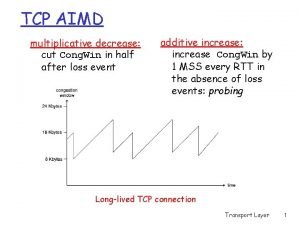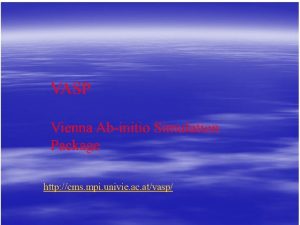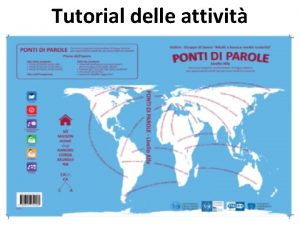AIMD Tutorial 2018 08 31 INCAR For AIMD













- Slides: 13

AIMD Tutorial 2018 -08 -31

INCAR (For AIMD) • NSW = 5000 ! # of steps • IBRION = 0 ! how the ions are updated and moved; Verlet algorithm for AIMD ! Others for relaxations into a local energy minimum ! SMASS allows additional control • ISIF = 2 ! Fixed cell (volume) parameter & ionic relaxation • SMASS = 0 ! canonical ensemble is simulated using the algorithm of Nosé • POTIM = 0. 5 [fs] ! Time-step • TEBEG = 300 [K] ! Room Temp. ; control the temperature during an ab-initio mulecular dynamics ! No initial velocities on the POSCAR file the velocities set randomly (Maxwell-Boltzmann distribution) -------------------------------------------------------------------------- • # PREC = High ! Precision; set ENCUT if no values is given for ENCUT • ENCUT = 600 [e. V] ! Cut-off energy for plane wave basis set in e. V • ISPIN = 2 ! spin polarized calculations • NELM = 999 ! maximum number of electronic SC (self-consistency) steps • IDIPOL = 3 ! dipole moment

POSCAR 1: Comment line 2: Lattice constant 3 -5: lattice vector 6 -7: atomic species and number of atoms 8: Selective dynamics (optional) 9: Cartesian or in direct (fractional) Coordinates of atoms Switch on or not ‘Selective dynamics’ (F=fix, T=move)

POTCAR (C) PAW_PBE C 08 Apr 2002 4. 000000000 parameters from PSCTR are: VRHFIN =C: s 2 p 2 LEXCH = PE ! Exchange-correlation type (PBE) EATOM = 147. 1560 e. V, 10. 8157 Ry TITEL = PAW_PBE C 08 Apr 2002 LULTRA = F use ultrasoft PP or not IUNSCR = 0 unscreen: 0 -lin 1 -nonlin 2 -no RPACOR =. 000 partial core radius POMASS = 12. 011; ZVAL = 4. 000 mass and valenz RCORE = 1. 500 outmost cutoff radius RWIGS = 1. 630; RWIGS =. 863 wigner-seitz radius (au A) ENMAX = 400. 000; ENMIN = 300. 000 e. V ICORE = 2 local potential LCOR = T correct aug charges LPAW = T paw PP EAUG = 644. 873 DEXC =. 000 RMAX = 2. 266 core radius for proj-oper RAUG = 1. 300 factor for augmentation sphere RDEP = 1. 501 radius for radial grids RDEPT = 1. 300 core radius for aug-charge QCUT = -5. 516; QGAM = 11. 032 optimization parameters Description (? ) l E TYP RCUT 0. 000 23 1. 200 1. 000 23 1. 500 1 2. 500 23 1. 500 2. 000 7 1. 500 Error from kinetic energy argument (e. V) NDATA = 100 STEP = 20. 000 1. 050 • Differences of POTCAR-type https: //cms. mpi. univie. ac. at/vasp/Recommended_PAW_potentials_DFT_calc ulations_using_vasp_5_2. html 1. 2. 3. 4. 5. _h: potential is harder than the standard (greater energy cutoff) _s: potential is softer than the standard _pv and _sv: p and s semi-core states are treated as valence states (i. e. for V_pv the 3 p states are treated as valence states, and for V_sv the 3 s and 3 p states are treated as valence states) _d: d semi core states as valence states Nothing: standard version

POTCAR • • • PSCTR: The PSCTR file controls the pseudopotential generation program and the calculation of the US pseudopotentials VRHFIN: get the valence electron configuration LEXCH: hybrid functional EATOM: the "energy of the pseudo-atom", which the pseudopotential (PP) was generated. RPACOR: partial core radius Example RCORE: outmost cutoff radius POMASS: atomic mass [a. u. ] ZVAL: valence for each atomic species ICORE: local potential LCOR: correct AUG charges RMAX: maximum radius for non-local projection operators QCUT: low q-value for optimization

KPOINT K-points 0 Monkhorst 221 000 ! number of k-points = 0; automatic generation scheme ! Monkhorst-pack ! k-point grids along reciprocal vectors ! optional; shift of the mesh • Reciprocal lattice = 역벡터를 적용해 얻어지는 가상의 격자 • Periodicity (Bloch theorem apply) Brillouin zone of reciprocal space • K-point = sampling points in 1 st BZ • determines how many k-points are used to sample the Brillouin zone • when more k-points are used, only the interaction between the atoms (which should be zero) is described more accurately • 3 rd line: G/g for generating meshes at the Gamma point; M/m selects Monkhorst-Pack scheme. r. l. vector ai, bi, ci P. E. Blöchl, ``Projector augmented-wave method'', Phys. Rev. B 50, 17953 (1994). G. Kresse, and J. Joubert, ``From ultrasoft pseudopotentials to the projector augmented wave method'', Phys. Rev. B 59, 1758 (1999).

https: //cms. mpi. univie. ac. at/wiki/index. php/KPOINTS KPOINT http: //cms. mpi. univie. ac. at/wiki/index. php/KPOINTS#Automati c_k-mesh_generation • Automatically generated k-point: in output file IBZKPT Cartesian (fcc-lattice) • three possible input formats (simple, normal, expert) 0. 25 0 0 • Here one can provide directly the generating basis vectors for the kpoint mesh (in cartesian or reciprocal coordinates). The input file has the following format: 0 0. 25 0 Automatic generation 0 Cartesian 0. 25 0. 00 0. 25 0 0 0. 25 0. 5 is equivalent to Monkhorst-pack 444 000

OSZICAR and stdout. txt file

OUTCAR – informations individual parts are separated by lines -----------------------------�� • first part: reading INCAR, POTCAR, POSCAR • nearest neighbor distances and analysis of symmetry • information on what was parsed from INCAR • verbose job information • information on lattice, k-points and positions • information on the basis set (number of plane waves) • non local pseudopotential information • information for each electronic step (one line in OSZICAR)

OUTCAR – writing • contributions to electronic energy at each electronic iteration • convergence information: each electronic step • Eigenvalues: each ionic step • DOS + charge density: each ionic step • total energy and electronic contributions: each ionic step • Stress: each ionic step • basis vectors: each ionic step • Forces: each ionic step

OUTCAR - example

OUTCAR – example

References • K-points : Chadi, Cohen, PRB 8 (1973) 5747 • 첨부파일 6_k-points. pdf : “Sampling the Brillouin-zone”, Andreas EICHLER • Monk. Horst-Pack : Hendrik J. Monkhorst and James D. Pack, Phys. Rev. B 1976, 13, 5188 • “Ab-initio molecular dynamics: theory and implementation”, Dominik Marx and Jurg Hutter
 Alex osterlind
Alex osterlind Aimd
Aimd Selective dynamics vasp
Selective dynamics vasp Dada la siguiente secuencia rusia 2018 rusia 2018
Dada la siguiente secuencia rusia 2018 rusia 2018 Steg för steg rita
Steg för steg rita Orubbliga rättigheter
Orubbliga rättigheter Bamse för de yngsta
Bamse för de yngsta Vad är densitet
Vad är densitet Ministerstyre för och nackdelar
Ministerstyre för och nackdelar Sju principer för tillitsbaserad styrning
Sju principer för tillitsbaserad styrning Kanaans land
Kanaans land Nationell inriktning för artificiell intelligens
Nationell inriktning för artificiell intelligens Nyckelkompetenser för livslångt lärande
Nyckelkompetenser för livslångt lärande Romarriket tidslinje
Romarriket tidslinje






















